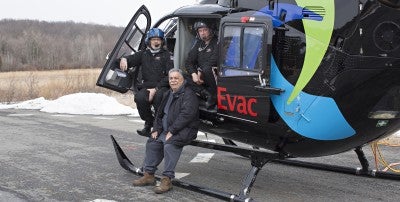
As Hector LaSalle picked up branches in his Mount Pocono yard following Superstorm Sandy, he had no idea a tempest was brewing inside his brain.
“All of a sudden, my hands felt numb, and I couldn’t speak,” says LaSalle, 62. “My right arm was like a piece of meat, no muscle control.” His face drooped, and his right leg was weak too. Alarmed family members brought him to Pocono Medical Center, where imaging revealed he’d suffered an intracranial hemorrhagic stroke.
Quickly, professionals at Pocono Medical Center loaded him into a MedEvac helicopter, which took him to Lehigh Valley Hospital–Cedar Crest. That hospital is certified by The Joint Commission as a Comprehensive Stroke Center, the nation’s highest designation for stroke care. “I remember the helicopter medic saying, ‘Stay with me, stay with me,’” LaSalle says. “He was like my savior.”
LaSalle’s stroke was caused by longstanding high blood pressure, the No. 1 risk factor for hemorrhagic stroke (bleeding in the brain from a burst blood vessel).
Until the stroke hit, LaSalle had no idea he was at risk. Due to long daily commutes to his job as a New York City elevator mechanic, he hadn’t seen a doctor in years. “You can’t feel blood pressure, whether it’s controlled or not,” says health network clinical nurse specialist Erin Conahan, RN. “Hector’s was about 200/112, which is extremely high.”
LaSalle agreed to participate in a multisite clinical trial of an FDA-approved drug to control acute high blood pressure, funded by the National Institutes of Health. Conducting such studies is part of the mission for Comprehensive Stroke Centers like Lehigh Valley Hospital. In this trial, “Patients receive either the standard of care or a more aggressive dose,” Schumacher says. “Hector was randomized to receive the aggressive treatment and did very well, though he still has some symptoms.”
“Whatever it did, it helped,” LaSalle says. “I felt the effect right away.” He is still rehabilitating his right arm, leg and speech, but can walk and talk. He’s now retired – and keeps better track of his blood pressure. “Had I known it was so high, I would have taken more precautions,” he says. “Having a stroke was a real awakening.”
